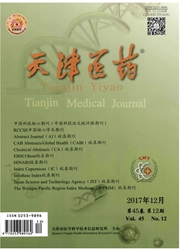

 中文摘要:
中文摘要:
目的探讨星形胶质细胞受到损伤刺激后弹性模量的变化.方法分离、提取新生2 d SD 大鼠星形胶质细胞,通过胶质纤维酸性蛋白(GFAP)抗体免疫荧光染色对其进行鉴定.实验分为对照组和损伤组,损伤组为应用细胞损伤仪损伤后6 h 的星形胶质细胞,对照组不予损伤.应用原子力显微镜在液相下测试各组细胞的弹性模量,并对两组结果进行比较、分析.结果大鼠星形胶质细胞纯化率达95%以上.损伤后6 h 的星形胶质细胞形态紊乱,部分细胞胞体可见肿胀.获得了星形胶质细胞的力学地形图和力压痕曲线.损伤组星形胶质细胞弹性模量较对照组显著增加[(1 689±693)Pa vs.(724±283)Pa,P〈0.01].结论损伤刺激会造成星形胶质细胞弹性模量增大,为进一步从细胞水平了解创伤性脑损伤后的颅内物理微环境提供理论基础.
 英文摘要:
英文摘要:
Objective To investigate changes of the elastic modulus of astrocytes induced by injury. Methods The astrocytes were isolated and extracted from the 2-day old SD rats, and identified by immunofluorescence staining with glial fiber acidic protein (GFAP) antibody. Cells were divided into control group and injured group. The injured group was astrocytes 6 h after being injured by the cell damage instrument. The control group was astrocytes without any injury. The elastic modulus in liquid phase was tested by atomic force microscope in two groups. Results were compared and analyzed between two groups. Results The purification rate of rat astrocytes was more than 95%. Six hours after the injury, the astrocytes were in disorder, and some of cell bodies were swelling. The mechanical topographic maps and force indentation curves were obtained. The elastic modulus of astrocytes was significantly increased in injured group compared with that of control group[(1 689±693) Pa vs. (724±283) Pa, P<0.01]. Conclusion The injury stimulus increases the elastic modulus of astrocytes, which provides theoretical basis for understanding intracranial physical microenvironment after traumatic brain injury in animal experiments.
 同期刊论文项目
同期刊论文项目
 同项目期刊论文
同项目期刊论文
 期刊信息
期刊信息
